価値あるワインダーに必要なのは安全性と信頼性です。では、そのワインダーを納め、陳列するために必要なケースには何が求められるのでしょう。見た目の美しさ、品質の高さ、頑強さ。むろん、そのどれもが必要です。しかしそれらだけでは足りません。このケースに求められる何より重要なものは人を魅了する「物語」だと私たちは考えています。
今から400年以上前、武具作りを生業としていた彦根の職人たちは、世の中が平定されるに従いその生産品目を仏壇に変え、匠の技は洗練を極めてきました。INOUEは1世紀以上前この地に誕生し、歴史の風雪に鍛えられた技を伝承するとともに、そこに新しい風を吹き込み未来へと物語を紡いでいます。
Watch winder ̶ an artistic product that preserves a value of wrist watch as it has been made ̶ simply needs two core essences, security and solidity. With such an importance of its function, what does it take to create its casing for display?
Regardless to say, aesthetic beauty, high quality, and durabili ty are considered as minimum and fundamental ethos. What is more and most important is a “story” , that defines the existence of the masterpiece. That ultimately allures people.
More than 400 years ago from now. As the world shifts from war era to peace era, craftsmen from Hikone, who were specialized at the production of armors, shifted its expertise to Buddhist altar a nd continued refining their artistic skills. INOUE emerged to the world more than a century ago. INOUE has been valuing ove r hundred years of craftsmanship skills, with a fusion of modernity to create a story that is coherent with the current context.

彦根に350年以上続く仏壇造り。この技術を工部七職と呼ばれる熟練の職人たちが、時代を継いで支えてきました。彼らは木材、金属、漆などの素材を自在に操り、高度な技術で美を形にしていきます。彼らとともに最高峰の作品造りを目指せること、これこそが私たちINOUEの誇りです。
Inoue’s techniques have accumulated been passed down over 350 years of crafting Japanese Buddhist altars in the town of Hikone. Elite craftsman, called the “Seven Masters,” employ their superior techniques to shape materials such as wood, metal, and lacquer. Today, more than 100 years since the founding of Inoue, our artisans prioritize cooperation with one another in their pursuit the possibilities that can be realized through application their crafts. In these modern times, we take pride in engaging in the peak of Japanese Buddhist altar creation.
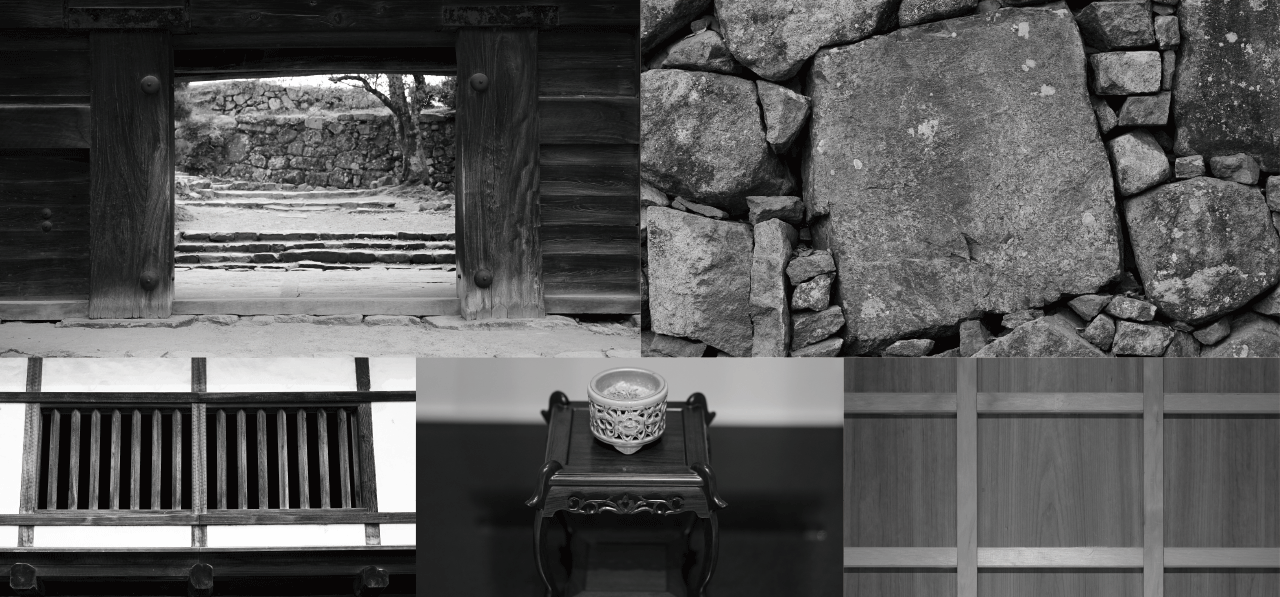
四方とは、東西南北の4つの方向を意味する言葉です。本製品は、立方体であるワインダーのシェルとなるよう設計されました。そこで、日本文化において、折り紙から茶室に至るまで応用される正方形を用い高品位な「箱」を作り上げました。ただモノを覆うのではなく、文化で包みこむように。
The Japanese word “Shihou” refers to the four (shi) cardinal directions (hou). This piece is designed as the shell to house a cubical winder. By adapting techniques ranging from origami to tea ceremony rooms, we created a high-end square shaped “box.” However, this is not just a container to put something in, this piece encases a winder by enveloping it within Japanese culture.
四方の文字通り、周囲四面を漆で塗り上げ、全体に蒔絵を施しました。蒔絵は、漆で仕上げた面の上に金・銀などの金属粉を蒔く技法であり、雅で華やかな雰囲気を醸し出します。
As the name suggests, the Shihou is a piece that is finished with lacquer across all four directioms. It is finished on all sides with a makie, which is method of Japanese lacquering in which, originally, powdered gold or silver are brushed into imeges drawn on the surface of the lacquer. The Shihou's makie evoke a feeling of elegance.
麻の葉 ASANOHA
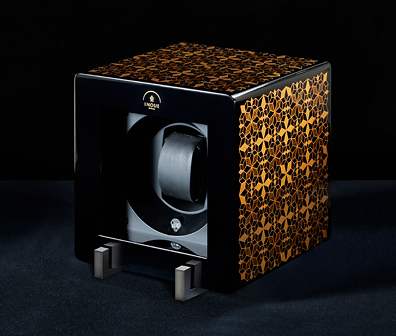
h155mm×w144mm×d163mm Swiss Kubik (winder)×1 個 [木地]ヒバ [ 塗り]天然漆塗り 蝋色(鏡面)仕上げ [蒔絵]手描き/ 研ぎ出し 及び 平磨き 蒔絵加工 [金具]台座:アルミニウム
Wood: Japanese hiba cypress Finish: natural lacquer,
highly polished roiro style
Makie: (Base) hand-drawn and polished makie
Metals: (Pedestal section) aluminium
※こちらのワインダーケースは、信頼性あるワインダーで有名な
スイスキュービック(SWISS Kubik)を装着する
専用装飾ケースとなっています。
Winder case on this catalog is crafted to cater SWISS Kubil,
on e of the most prestigious winders.
亀甲 KIKKOU

市松 ICHIMATSU
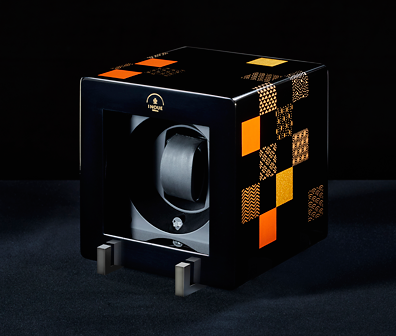
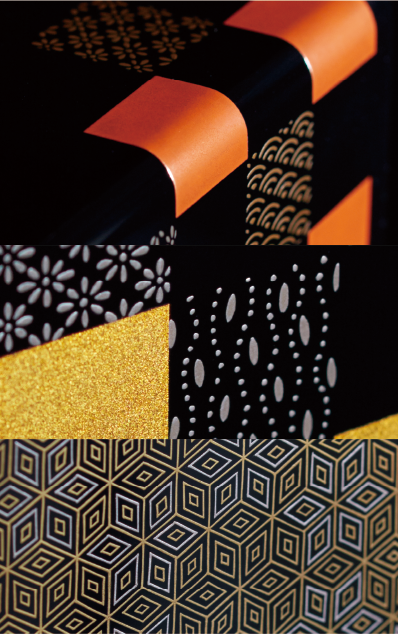
[material] 本体に使用されているのはヒバ。耐久性に優れた木材として知られ、日本でも古くから家屋や家具に用いられています。
The main body is constructed from Japanese hiba cypress. Hiba wood is known for its durability, and has been used in building homes and furniture in Japan since antiquity.
[material]漆はウルシノキの樹液で、ゴミや埃を濾した後に用いられます。空気中の水分と結合し硬化する世界最強の保護塗料のひとつです。
Japanese lacquer, called urushi, comes from the sap of the Japanese urushi tree. The sap is used after it is filtered to remove any dirt or other particles. Through being exposed to the moisture in the air, it hardens into one of the strongest protective coatings in the world.
[technique] 「蒔絵」は 器物の表面に漆で文様を描き、金、銀などの金属粉等を蒔きつけて付着させる、奈良時代より始まる日本独自の漆工芸技法です。
Makie is a technique of affixing images onto the surface of lacquerware by drawing pictures and embedding usually gold or silver powder into them with a brush. This unique method of lacquer artistry first began in the 8th century.
[design] 本製品は1種類ずつ異なる文様を施しています。どちらも日本の伝統的な柄であり、品格と装飾性に優れたものです。
Each design pattern in this piece is incorporated one by one, and they are all traditional Japanese patterns with superb sophistication and aesthetic sense.
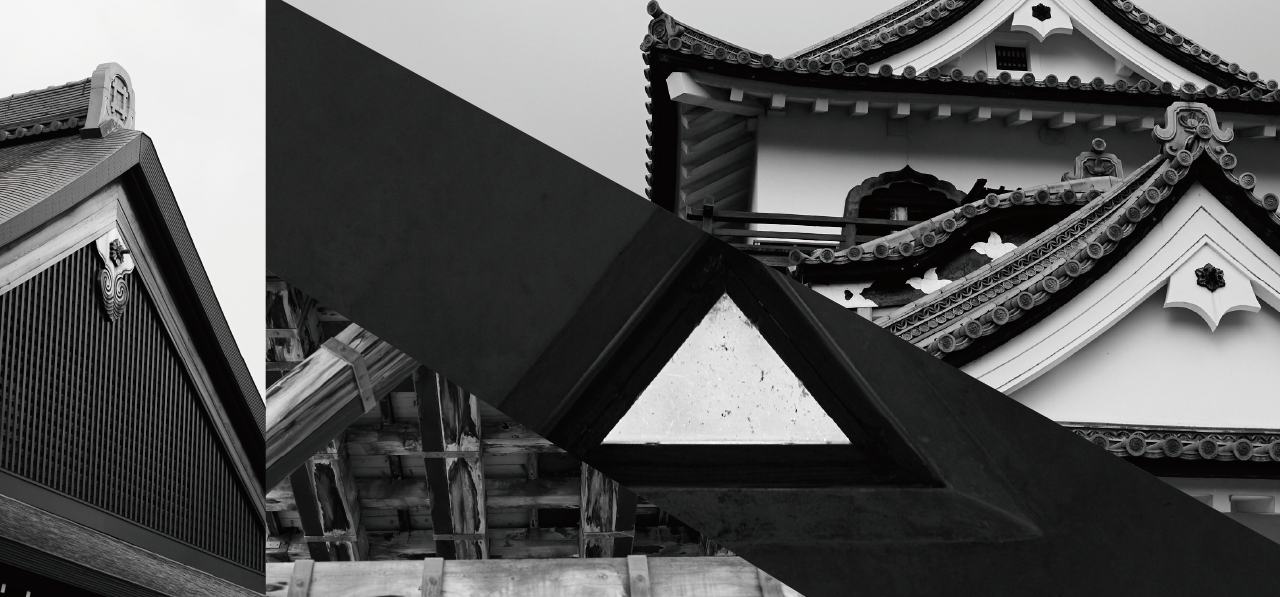
日本の「組子」を造形に取り入れたのが「破風」です。組子は釘を用いずに木を組み上げる木工技術。その精緻さと美しさは圧巻です。今回はその技術をフレームワークとして用いました。そして、ワインダーを大きく三角に配置し、日本の破風と霊峰に思いを馳せています。
The Hafu is formed using the Japanese technique of kumiko, a process of joining and assembling wood into a structure without the use of nails, to create breathtakingly elaborate and beautiful works. The framework is made using kumiko techniques to arrange winders into a triangular position that brings to mind the curved roofs of Japan’s traditional architecture and the peaks of its sacred mountains.
フレームワークに組子技術を用いたことで、繊細なイメージを保ちながらも強度を手に入れました。黒い漆を前面に塗り上げ、正面に金の金細工を取り付けて力強さをも同時に演出しています。三角の形状が、日本の伝統的な意匠「破風」を彷彿とさせます。
The framework employs the kumiko technique, which maintains an heir of delicateness, while at the same time it is built to be sturdy. The front surface is finished with black lacquer and the central section is emblazoned with gold fittings, giving the piece a sense of power. The triangular shape is a design reminiscent of the hafu style used in the roofs of traditional buildings.
<HAFU> Type3
w660mm×h462mm×d354mm
Swiss Kubik(winder)×3個
[木地]台:合板 / 本体:ヒバ(桧科)、合板
[塗り]本体:天然漆塗り カシュー塗り仕上げ
台座:天然漆塗り 蝋色(鏡面)仕上げ
[蒔絵]手描き/平磨き 及び 京都オパール彩輝光加工
[金具]本体:プレス金具 消し金メッキ仕上げ
Wood:(Main piece and base) :Japanese hiba cypress, plywood,
Finish:(Main piece) natural lacquer, cashew tree sap
(Base) natural lacquer, highly polished roiro style
Makie:(Base) hand-drawn and polished makie,
Kyoto Opal polished
Metal fitting: Main piece and base:
Pressed gilding with burnishing
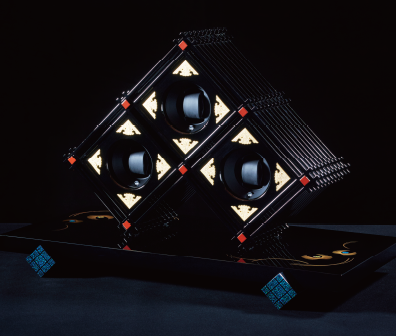
<HAFU> Type1
w278mm×h298mm×d181mm
Swiss Kubik(winder)×1個
[木地]台:合板 / 本体:ヒバ(桧科)、合板
[塗り]本体・台座:ともカシュー塗り仕上げ
[金具]本体:プレス金具 消し金メッキ仕上げ
Wood:Main piece:Japanese hiba cypress plywood
Wood:Base:Japanese hiba cypress
Finish: (Main piece and Base:Cashew lacquer finish
Metal fitting:Main piece and base:
pressed gilding with burnishing
※こちらのワインダーケースは、信頼性あるワインダーで有名な
スイスキュービック(SWISS Kubik)を装着する
専用装飾ケースとなっています。
Winder case on this catalog is crafted to cater SWISS Kubil,
on e of the most prestigious winders.

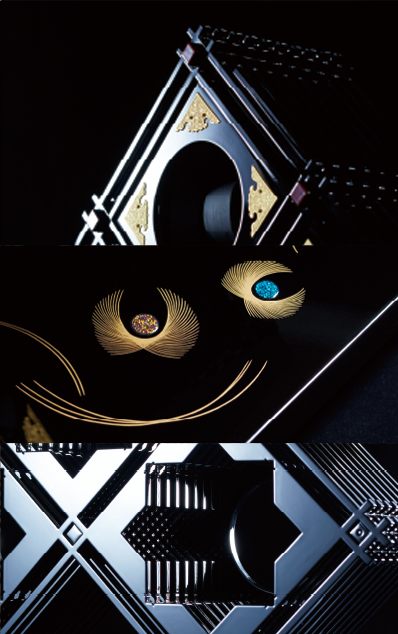
[technique] 組子は、日本全国で様々な形状があります。釘などを使うことなく木材をしっかり噛み合わせることができ、強度に優れます。
Kumiko is used in a variety of forms throughout Japan. Without using any kind of nails, pieces of wood are fit together firmly to create an exceedingly strong structure.
[technique]台には「彩輝光」という漆工芸の新技法を用いました。細かな京都オパールを漆で付着させ、塗り重ねた漆を研ぎ出して表現しています。
The base employees a new lacquer craft called saikiko. This is an expression of lacquer made by setting small “Kyoto Opal” stones into the lacquer and coating with lacquer that is burnished smooth.
[image] 破風は日本の伝統的の屋根に見られる意匠です。屋根が持ち上がった部分を指し、神社仏閣、城などを荘厳に見せる効果があります。
Hafu is a traditional design seen often in Japanese roofs. It refers to the upward curving at the edges of triangular Japanese rooves. It is often used to augment the grandeur of buildings such as shrines, temples, and castles.
[material]本来は継ぎ目を隠し、意匠を高める金具を表面の四隅に用いることで、素材にコントラストをもたらしています。
Metal fittings on the surface of the four corners enhance the design while hiding the joints from being visible and highlighting a contrast between the materials.
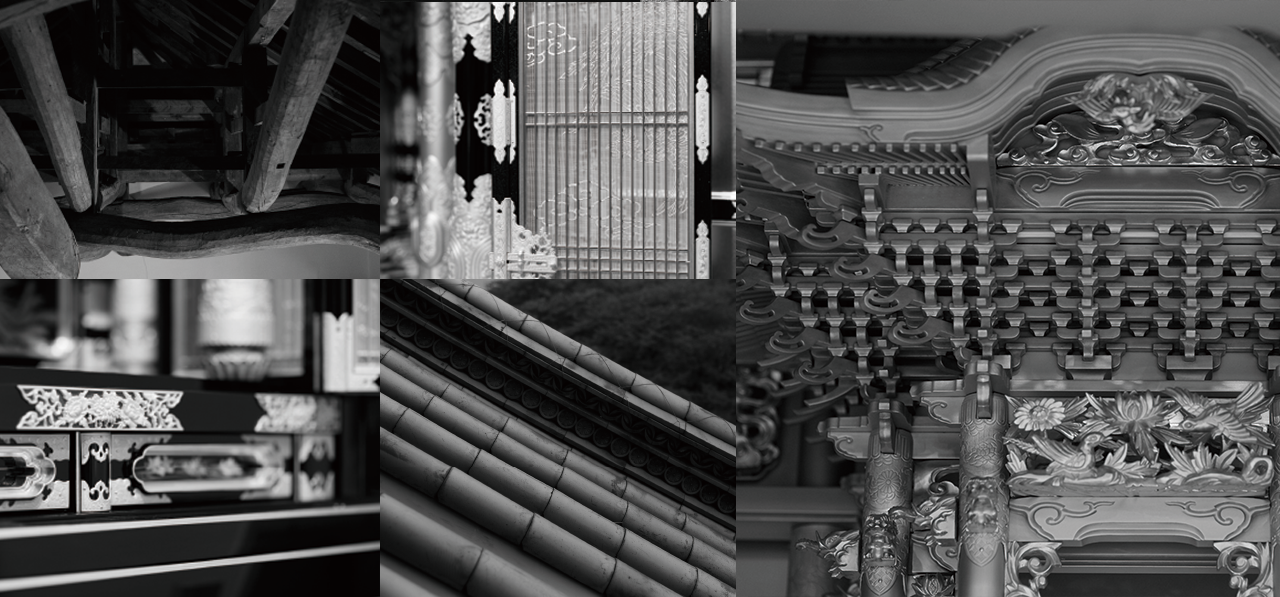
宮殿とは仏像などを安置するための小さな神社仏閣の姿をした仏具です。重要なものを安置するため、彫刻や升組み、金物などあらゆる技術を用いました。細部にこそ魂が宿る。日本美の真髄がここにあります。
The most unique characteristic of that the enclosure made by masugumi, a technique of precisely assembling of pieces of wood, that is coated with a tamenuri style of lacquer finish. The sliding front door is decorated with Japanese traditional designs using the raden technique of inlaying mother of pearl, and the hyomon method of applying a thin layer of gold over the lacquer.
本製品最大の特徴は、周囲を覆う宮殿升組み。緻密に組み上げられた升組みすべてに溜め塗りという技法で漆が施されています。表のスライドする扉には、青貝を用いる螺鈿技法と金の薄い延べ板を用いる平(ひょう)文(もん)技法を用い、日本の伝統的な意匠が華やかさを演出します。
The most unique characteristic of that the enclosure made by masugumi, a technique of precisely assembling of pieces of wood, that is coated with a tamenuri style of lacquer finish. The sliding front door is decorated with Japanese traditional designs using the raden technique of inlaying mother of pearl, and the hyomon method of applying a thin layer of gold over the lacquer.
w902mm(max1340mm)×h663mm×d140mm
Swiss Kubik(winder)× 10個
[木地]升:ヒバ / 本体・扉:ヒバ・合板
[ 塗り]天然漆塗り 扉本体は蝋色(鏡面)仕上げ
[蒔絵]手描き/研ぎ出し 及び 平磨き 蒔絵加工
[金具]扉:プレス金具 消し金メッキ仕上げ
Wood: (Masugumi blocks) Japanese hiba cypress
(Main piece and door): Japanese hiba cypress/plywood
Finish: natural lacquer, highly polished roiro style
Makie: (Door) hand-drawn and polished gold image
Metal: (Door) pressed gilding with burnishing.
※こちらのワインダーケースは、信頼性あるワインダーで有名な
スイスキュービック(SWISS Kubik)を装着する
専用装飾ケースとなっています。
Winder case on this catalog is crafted to cater SWISS Kubil,
on e of the most prestigious winders.
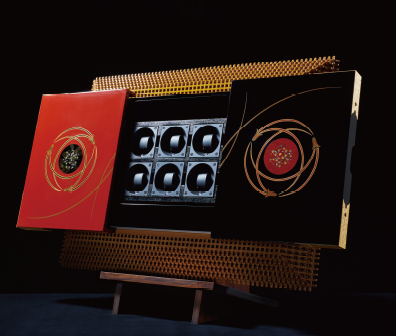

[technique]溜め塗りとは、下地の上に中塗りとして色漆を塗り、その上に透き漆を塗ったもので、下色を浮きだたせる技法です。
In the tamenuri lacquer technique, over the foundation layer, a middle coating of colored lacquer is applied, then on top of that a clear coat is applied so that the colors of the lower layers will show through to the surface.
[technique]螺鈿は、カットした青貝を用いて絵柄を作り上げる蒔絵技法です。青貝が光り輝くことで、絵柄が生まれる装飾技術です。
Japanese lacquer, called urushi, comes from the sap of the Japanese urushi tree. The sap is used after it is filtered to remove any dirt or other particles. Through being exposed to the moisture in the air, it hardens into one of the strongest protective coatings in the world.
[technique]平文は、金の薄い延べ板を用いて絵柄を作り上げる蒔絵技法です。金が光り輝くことで、絵柄が生まれます。純金ならではの輝きです。
Hyomon is a method of makie in which a thin layer of gold is used to create a picture in lacquer. The gleam of the gold brings out an image that shines as only pure gold can.
[technique]蝋色仕上げは、塗った漆を平坦に研ぎ、生漆を何度も摺り込んで鏡面に仕上げ、磨くことで艶を出す、漆塗り最高級の技法とされています。
In roiro, or highly-polished lacquer finishing, a lacquered surface is burnished flat and then raw lacquer is applied repeatedly. Finally, it is polished to achieve a mirror-like sheen. This method represents the very highest quality of lacquering.

彦根仏壇の特徴の一つである木目出し塗リが美しい最大サイズのワイン ダーケースです。彦根仏壇の技術の粋をすべてが詰め込まれています。扉の裏には美しい春秋の景色が表現ざれ、随所に蒔絵、金工、木工、すべてに職人の手仕事が施されています。このケースにはワインダーが16個収納可能です。価値ある腕時計にとって安心の保管場所となります。
DAN Spec, the largest winder casing, is attributed to aesthetic finish that is derived from wooden grain. The entire techniques of Hikone craftsmen are introduced on this masterpiece. The back of door displays the seasonality of spring and fall - with details in all essences - makie, metalwork, woodwork- are meticulously catered by craftsmen. This casing caters 16 winders - an ultimate casing to rest valuable wrist watches.
<DAN>
h1800mm × w675mm x d400mm
SWISS Kubik(winder)×16個
[木地] ヒバ、合板、栓突板
[塗リ] 木目部分、扉裏蒔絵部分:天然漆塗り 蝋色(鏡面)仕上げ
/ その他:カシュー塗リ仕上げ
[蒔絵]手描き / 研ぎ出し 及び 平磨き 蒔絵加工
[金箔・金粉] 本金箔・本金粉
[金具] 障子:手彫金具 / 扉:エッチング金具 / 扉蝶番:手彫金具
/ 内部:プレス金具 消し金メッキ仕上げ
Wood:Japanese hiba cypress.plywood
Finish:Wood and Back of doors:Natural lacquer, highly polished roiro style Other:Cashew lacquer finish
Makie:Hand-drawn and polished makie
Gold foil / Gold powder:Genuine gold foil and gold powder
Metal fitting:Shoji:Handcrafted metal
/ fittingDoor:Eyching metal fitting
Door hinge:Handcrarted metal fitting
/ Inside:Pressed gilding with burnishing
※こちらのワインダーケースは、信頼性あるワインダーで有名な
スイスキュービック(SWISS Kubik)を装着する
専用装飾ケースとなっています。
Winder case on this catalog is crafted to cater SWISS Kubil,
on e of the most prestigious winders.
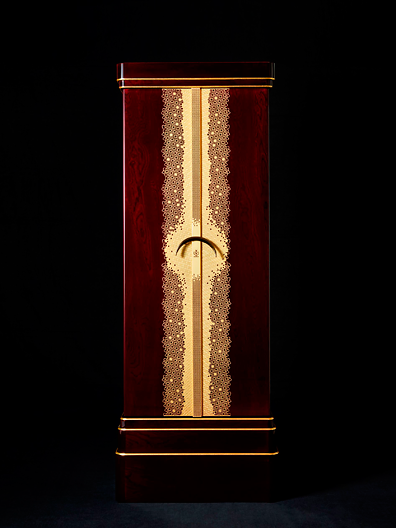
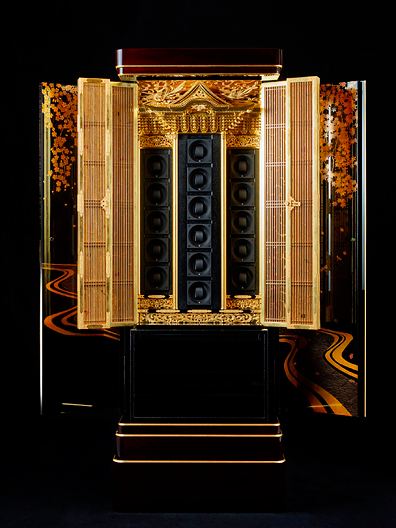
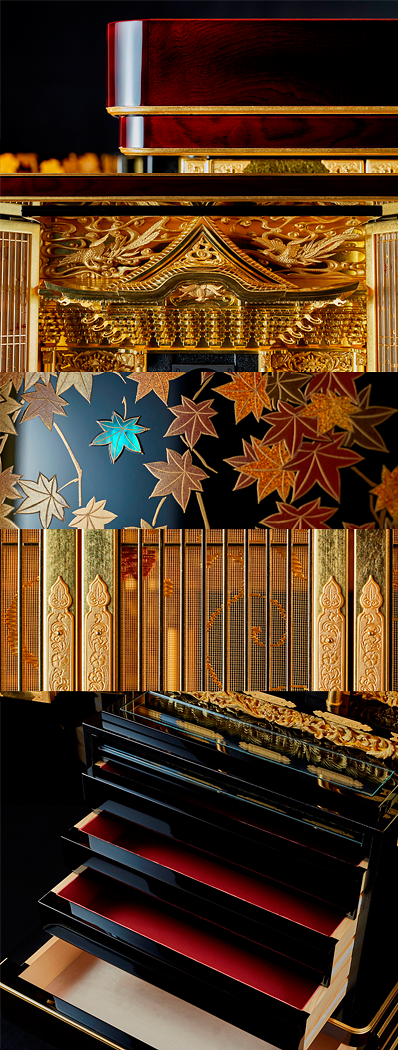
[materral]
本体に使用ざれているのはヒバ。耐久性に優れた木材として知られ、日本でも古くから家屋や家具に用いられています。
The main body is constructed from Japanese hiba cypress. Hiba wood is known for its durability, and has been used in building homes and furniture in Japan since antiquity.
[technique]
「蒔絵」は器物の表面に漆で文様を描き、金、銀などの金属粉等を蒔きつけて付着させる、奈良時代よリ始まる日本独自の漆工芸技法です。
Makie is a technique of affixing images onto the surface of lacquerware by drawing pictures and embedding usually gold or silver powder into them with a brush. Th is unique method of lacquer artistry first began in the 8th century.
[material]
漆はウルシノキの樹液で、ゴミや埃を濾した後に用いられます。空気中の水分と結合し硬化する世界最強の保護塗料のひとつです。
Japanese lacquer, called urushi, comes from the sap of the Japanese urushi tree. The sap is used after it is filtered to remove any dirt or other particles. Through being exposed to the moisture in the air, it hardens into one of the strongest protective coatings in the world.
[technique]
蝋色仕上げは、塗った漆を平坦に研ぎ、生漆を何度も摺リ込んで鏡面に仕上げ、磨くことで艶を出す、漆塗り最高級の技法とされています。
ln roiro, or highly-polished lacquer finTshing, a lacquered surface is burnished fiat and then raw lacquer is applied repeatedly. Finally, it is polished to achieve a mirror-like sheen. This method represents the very highest quality of lacquering.

こだわりに添える工芸の美
信頼あるワインダーで名高いSWISS KubiKに、日本国内で漆と蒔絵を施しました。 漆黒の艶やかな輝きと熟練の職人による精緻な金蒔絵が、あなたのこだわりの時計を引き立てます。
<KISSHO>
w100mm × h100mm × d100mm
weight 770g
※職人による手づくりのため、一品一品重量・
寸法・蒔絵など微妙に異なる場合があります。
[ベース]アルミニウム
[塗り]天然漆塗り 蝋色(鏡面)仕上げ
[蒔絵]手描き / 平磨き 蒔絵加工
機械式時計のゼンマイを自動的に巻き上げるケースです。
回転方向と1日あたりの回転数をPCから簡単に設定できます。
内部機構は一貫したスイス産で、ノイズが殆ど出ません。
固定クリップは全ての腕時計に対応しています。
単2アルカリ電池2本使用で長期使用できます。
メーカー国際保証3年間。
※こちらのワインダーケースは、信頼性あるワインダーで有名な
スイスキュービック(SWISS Kubik)本体を装飾した商品です。
渦千鳥 Uzu-Chidori
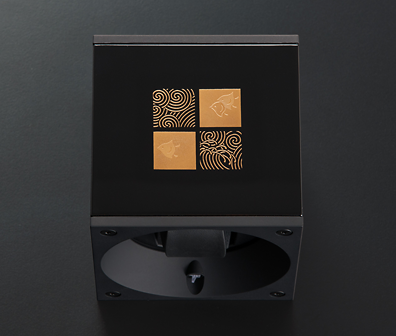
水辺の〈千鳥〉は楽しげに飛ぶ様から、古くから紋様として好まれて きました。永遠に形を変え続ける水を表す〈渦紋〉に合わせました。
花七宝 Hana-Shippo
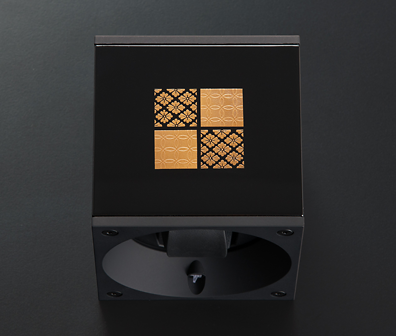
〈七宝紋〉は古くから輪違と呼ばれ、円が組み合いながら四方八方に広がっていく吉祥紋です。相性の良い〈唐花〉と合わせました。
波鱗 Nami-Uroko
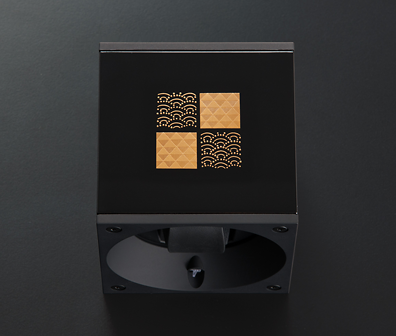
絶えず押し寄せる波を文様化した〈青海波〉に、三角が連続する〈鱗紋〉 を合わせた蒔絵です。共に絶えず広がる縁起を持つ吉祥紋です。
KISSHOは信頼あるワインダーで名高いSWISS KubiKに、日本国内で漆と蒔絵を施したものです。
彦根仏壇の株式会社井上とSWISS KubiKの日本代理店MASUDA-INFINITY-JAPAN株式会社が共同で開発しました。
株式会社 井上
INOUE Inc.
522-0031 滋賀県彦根市芹中町50番地
Phone: 0749-22-1587
Fax: 0749-22-1333
50, Serinaka-cho, Hikone, Shiga 522-0031, JAPAN
Phone: +81-749-22-1587
Fax: +81-749-22-1333
Web: www.inouehikone.jp
Mail: info@inouehikone.jp